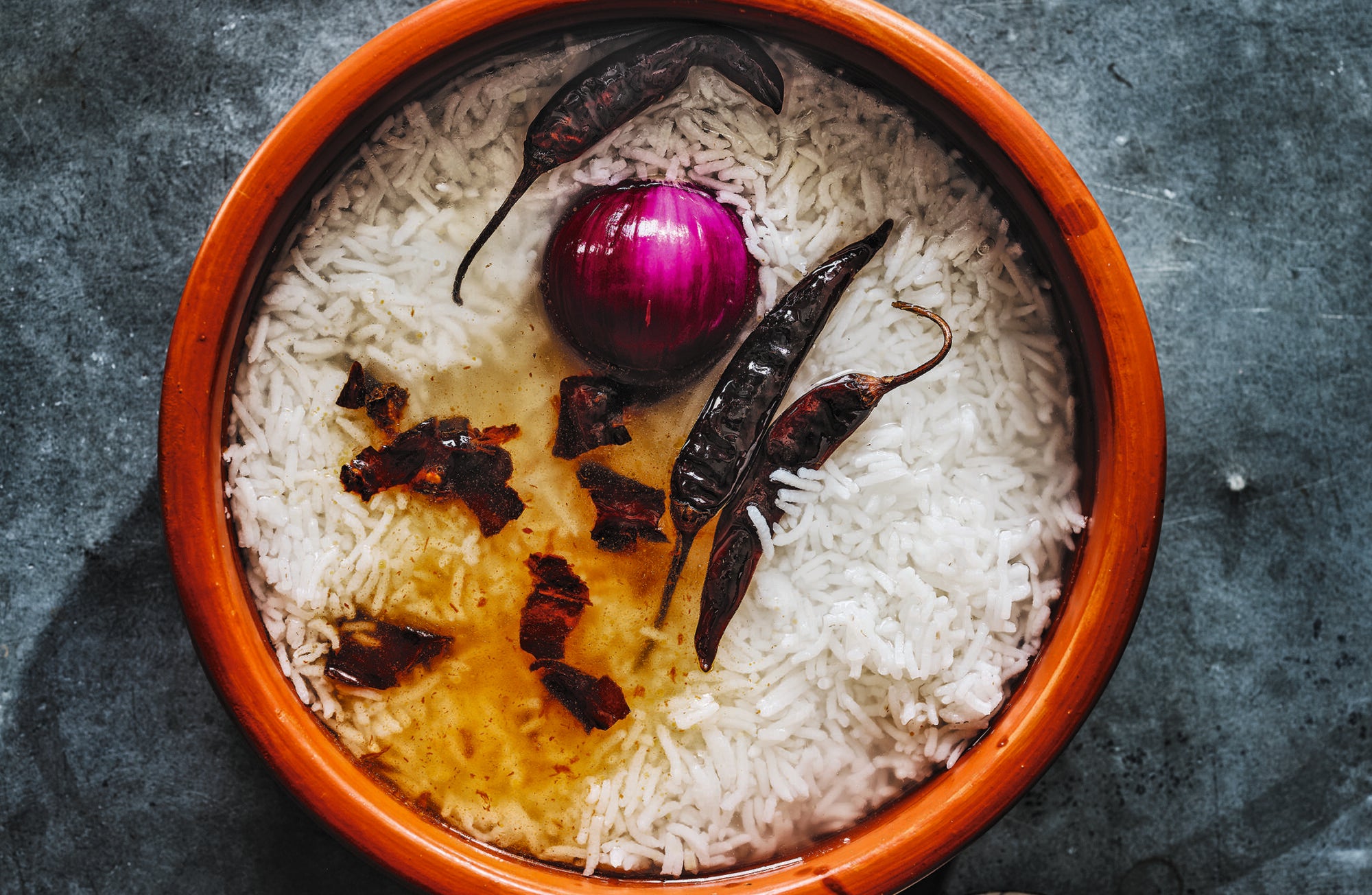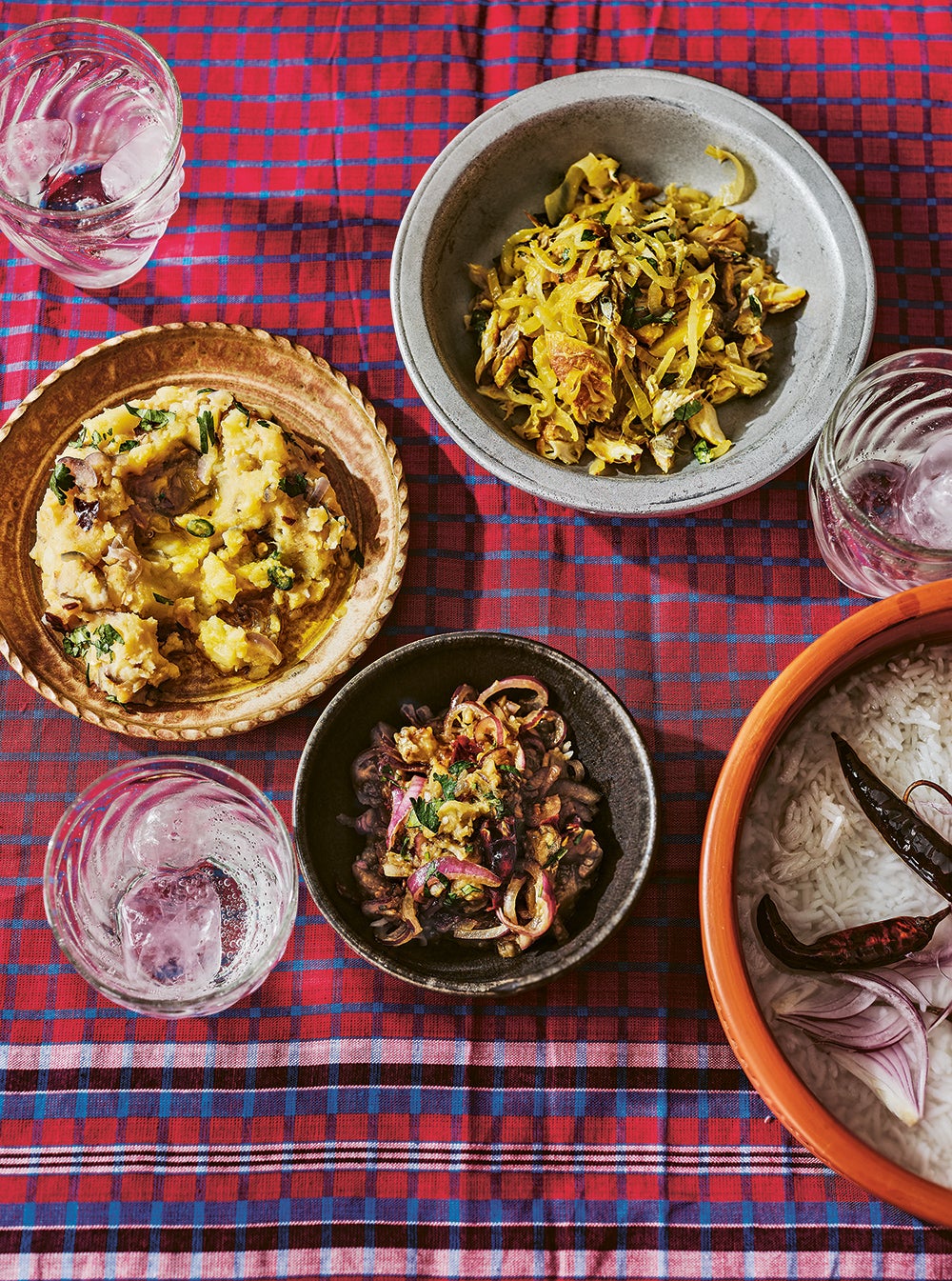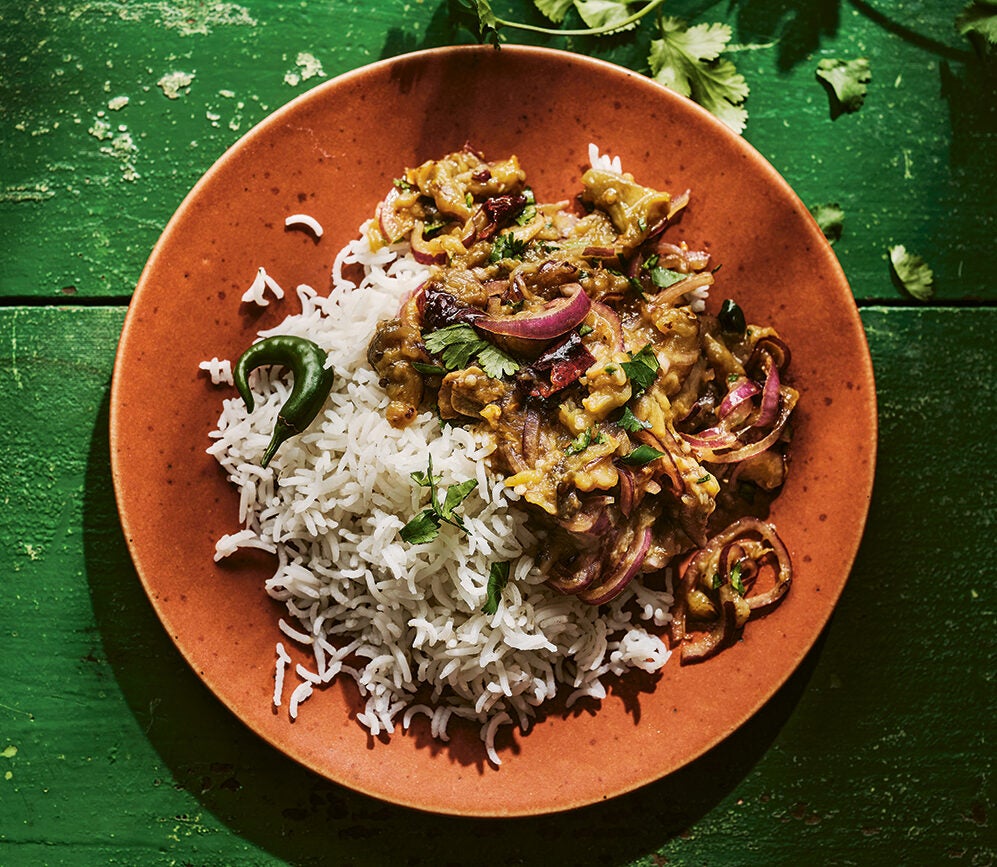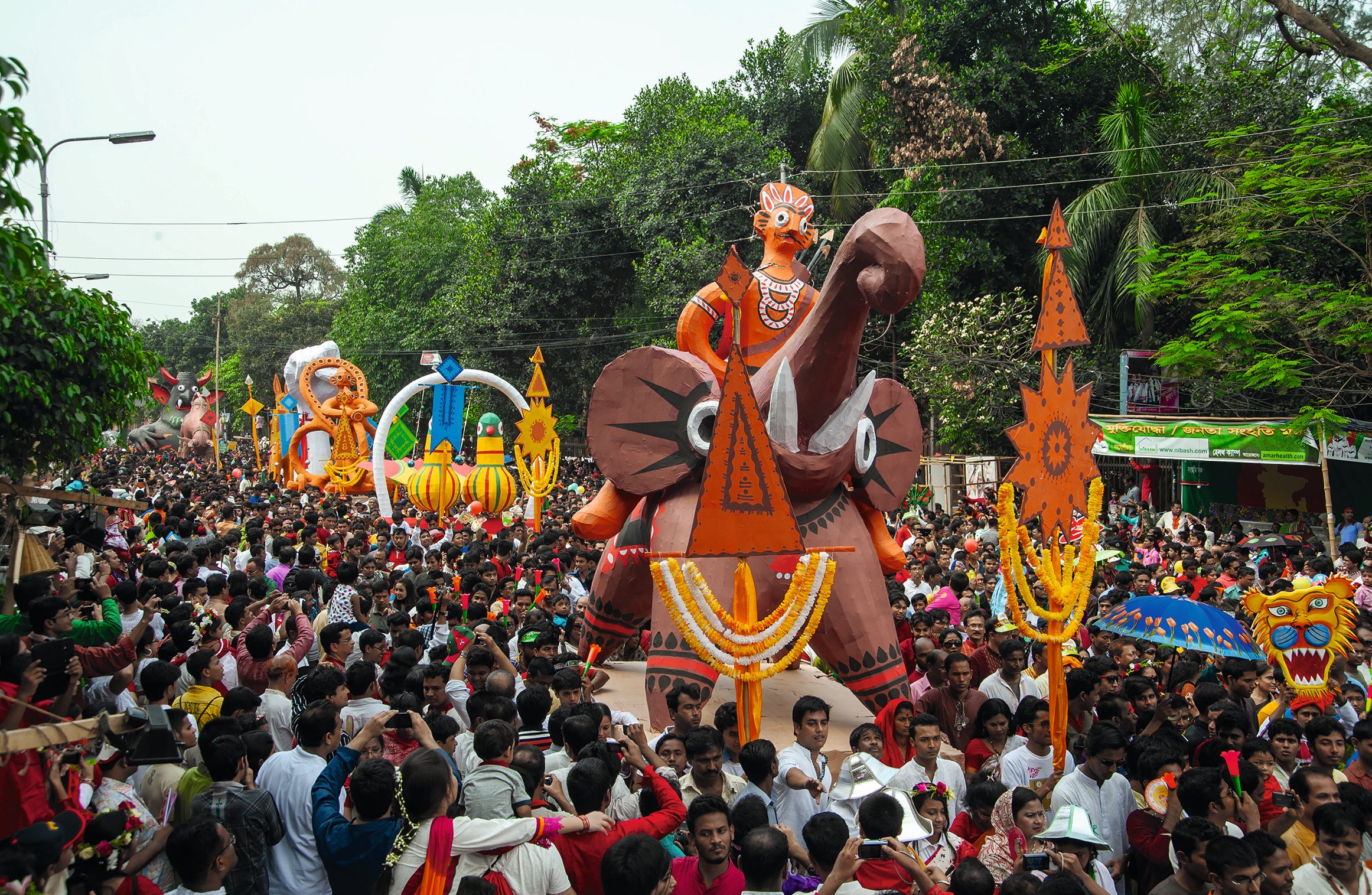
How a funky fermented rice dish represents Bangladesh’s historic past and vibrant future
No food encapsulates the essence of Bengal as wholly as panta bhat. There is hardly anything elaborate about this dish—leftover cooked rice soaked in water at room temperature, usually overnight, with a little salt, sometimes mustard oil and lime, until the grains are plumped and fermented. For many Bangladeshis, particularly millennials like me who grew up in upper-middle-class homes, its faint acerbic redolence carries a sense of folklorish mysticism. While many of us heard tales of our parents eating panta bhat in their younger years as breakfast and lunch on hot summer days, the dish was rarely present at our dinner tables growing up. That’s not to say there was no panta bhat in our kitchens at all—my dadi (paternal grandmother), for example, made it often, not for us but for the unhoused around our neighborhood in Chittagong, Bangladesh. She served the plate of soaked rice with the remnants of our lunches and dinners from the week to the hundreds of people who came knocking on our door for as long as she lived.
But every April 14, on Pohela Boishakh (Bengali New Year), panta bhat Cinderellas from salvaged sustenance to a grand, celebratory dish. The fermented rice itself stays largely the same, but in place of refrigerator scraps, it is served with a fleet of freshly made bhortas (Bengali mashes); spinach or amaranth shak (stir-fried greens); and fried, fatty hilsa, our national fish. As kids, my brothers and I did not jump for joy at the sight of this spread. My father, however, insisted that we had to eat it, even if it was just a bite or two, because it was Bengali New Year, and it was time to pay for our yearly subscription to Bengaliness.

A spread of panta bhat and bharta toppings. Photo by Haarala Hamilton from Made in Bangladesh by Dina Begum
Panta bhat’s rural ties predate its role in Pohela Boishakh by several generations. The earliest recorded evidence of the dish can be found in the writings of the Portuguese missionary Fray Sebastien Manrique. During his travels in the 17th century to what is now Bangladesh, Manrique noted that panta bhat was the daily meal of the masses, while those in the upper echelon of society ate foods rich in ghee and dairy.
While it’s hard to pinpoint its true origins, scholars like Krishnendu Ray, a professor of food studies at NYU, and Sanhita Dasgupta Sensarma, a Kolkata-based food researcher and chef, agree that panta bhat was born out of necessary frugality. “Most South Asian foods, especially of the Bengal Delta, which is the largest delta in the world, is the food of the peasantry,” says Ray. “The source of cheap calories with lashings of assertive flavors, including chiles, filled the desires of the peasantry and made the mildly flavored complex carbohydrate core go down easily.”
Wasting rice is never an option in a Bengali home. The lore repeated in my Bengali-Muslim household was that Allah tasks a hundred angels with making just one grain of rice. The fear of angering upper management was enough to make me lick my plate clean and, in my adult years, has manifested in a Pavlovian need to pick any remaining grains of rice off others’ plates. “Culturally, we rice-dependent Bengalis cannot bring ourselves to throw away something that we value so intrinsically,” explains Sensarma, who has studied the culinary evolution of Bengal for the last three decades. “Cooked rice left on its own, especially in the summer, can rot easily. But when soaked in water, it surprisingly doesn’t rot but ferments, enriching the rice with gut-friendly probiotics, amino acids, and nutrients.” Turning leftover rice into panta bhat was an essential preservation technique in the region until refrigerators became a common household appliance—at least for those who could afford them.
Back in the 1970s, Sensarma’s parents, both science scholars, were working on their PhDs, so they had a refrigerator (a novelty item back then) at home—“which is possibly why panta didn’t feature on our table,” she explains. Similarly, Ray says that his family didn’t get a refrigerator until 1974—and to his dismay, it destroyed the tradition of pakhala bhata. Now his mother only makes the dish as a midday meal for their family gardener, who expects a plate of panta bhat and cash as payment for his services.

Photo by Haarala Hamilton from Made in Bangladesh by Dina Begum
While the ’70s refrigeration era made panta bhat a bygone relic among West Bengal’s upper-middle class, a revolution was afoot just across the eastern border. East Pakistan, with a large Bengali Muslim population, began liberating itself from West Pakistan, where Urdu was the primary language, in 1971. Conflict arose when aspects of Bengali culture—our language, arts, and music, shared by Bengali Muslims and Hindus alike—were deemed too “foreign to Islam” by the ruling government in the West. When the newly independent Bangladesh emerged in 1971, linguistic and ethnic heritage as well as our ties to our “peasant roots,” regardless of religion, were the basis of a new national identity.
To newly minted Bangladeshis, “gorom bhat,” or warm, freshly cooked rice, became a sign of well-being and abundance, slowly scrubbing the presence of panta bhat from the dinner table over time. But the dish took on a different role in commercial spheres. “According to the newspaper Bhorer Kagoj, panta bhat stalls came up in newer market areas of Dhaka, the country’s capital, after Bangladesh became independent,” explains Tanushree Bhowmik, food researcher and founder of the blog Forktales. “They sold panta bhat as a sign of nationalism, an essential connection to ‘graam Bangla’ [agrarian Bangladesh] and its people.”
Eating panta bhat to affirm one’s Bengali identity on Pohela Boishakh is hardly an age-old tradition. In fact, for Bengalis across the border in Eastern India (also known as West Bengal), it isn’t a tradition at all—something I learned recently while researching this story. When I asked Ray, a fellow Bengali born and raised in West Bengal, about eating panta bhat on Pohela Boishakh, he was unfamiliar with the practice.
He did, however, associate the dish with visits to his grandparents, who lived in a small town in India called Balasore, in coastal Odisha. “Panta bhat (in my father tongue, Bengali) and pakhala bhata (in my mother tongue, Odia) was something we associated with the rural, small-town taste of summer,” he explains. “I ate it every summer with dozens of cousins named Laltu, Mintu, Fultusi, et cetera—always on the floor, never at the dining table,” he recalls. “Cross-legged, we devoured panta bhat with a drizzle of mustard oil, green chiles, raw shallots, fresh-squeezed lime juice, salt, sometimes a side of wood-ash-roasted snails or pan-fried small fish caught in the pond, sour and salty pickles, sautéed foraged greens, and sometimes shallow-fried potatoes.”
It wasn’t until the 1980s that panta bhat’s association with Bengali New Year was conceived. In 1983, the famed Bangladeshi journalist Borhan Ahmed proposed to a group of fellow journalists, poets, and academics the idea of starting a new tradition of sharing a breakfast of panta bhat on Pohela Boishakh, according to Sensarma. The suggestion was emphatically embraced by intellectuals like poets Faruk Mahmud and Sikdar Aminul Haq and journalists Mahbub Hassan and Shahidul Haque Khan, who initially paired panta bhat with minimal accompaniments like fried eggs, chiles, and shallots.

The crowd at a Pohela Boishakh celebration. Photo by Habibul Haque from Made in Bangladesh by Dina Begum
Soon hilsa (also called ilish), a perilously bony fish that migrates from the Indian Ocean to the rivers of the Bengal Delta, was added to the menu. The combination of rice and fish is an especially assertive symbol of Bengali identity regardless of nationality because, as the Bengali saying goes, “Mache bhate Bangali” (“Fish and rice make up a Bengali”). For Bangladeshis, the choice of hilsa makes the symbolism particularly potent because it’s said that outsiders—in this case Pakistanis—can neither appreciate the fish and rice combination nor handle deboning the fish. In the minds and on the tables of Bangladeshis, panta bhat is now forever entangled with hilsa, but in the last decade or so, the fish has been inching toward extinction. Now an exorbitant price tag has made it all but a rarity, which, according to Dhaka-based chef Sameera Wadood, is starting to chip away at panta bhat’s significance on Pohela Boishakh.
Its other most common pairing, with bhorta, or mashes, is also rooted in the foodways of Bengali peasantry as a way to prevent food waste. Potato, eggplant, bitter gourd, and dried fish (shutki) are the most common bases—at least where I grew up—but these days practically anything can be made into a bhorta. Chopped green chiles and cilantro, salt, toasted dried chiles, and sliced shallots are mixed into the base with the help of mustard oil, which quilts the kaleidoscopic flavors of the bhorta together.
This relatively new adaptation has its critics, too. “In recent years, there is a growing opinion that the ‘Sanskritization’ of panta, combining it with expensive ingredients such as ilish and large spreads of bhortas, and associating it with Dhaka’s culture on Pohela Boishakh is an appropriation of the food that the rural poor ate,” says Bhowmik. But for many young Bangladeshis across the diaspora, it’s a tether to their Bengali roots. In 2021, MasterChef Australia finalist Kishwar Chowdhury’s finale dish—panta bhat (which she called smoked rice water), aloo (potato) bhorta, and fried sardines—stunned the judges and Bengalis alike, but not for the same reason. The judges marveled at the paradox of complex simplicity in her dish, while some Bengalis argued it was “too lowly” and others praised it for being perfectly Bengali.
In her latest cookbook, Made in Bangladesh, author Dina Begum channels her newfound appreciation for panta bhat as an adult. She admits that she didn’t really eat much of it growing up in the UK but says that its fermented funk remains rife with nostalgia. “It always reminds me of Bangladesh and village life, where breakfast was slow and unhurried.” Along with one for panta bhat, her book contains three classic bhorta recipes—potato, eggplant, and fried fish—that together become a transformative meal representing a unified Bangladesh—or at least the hope for one.